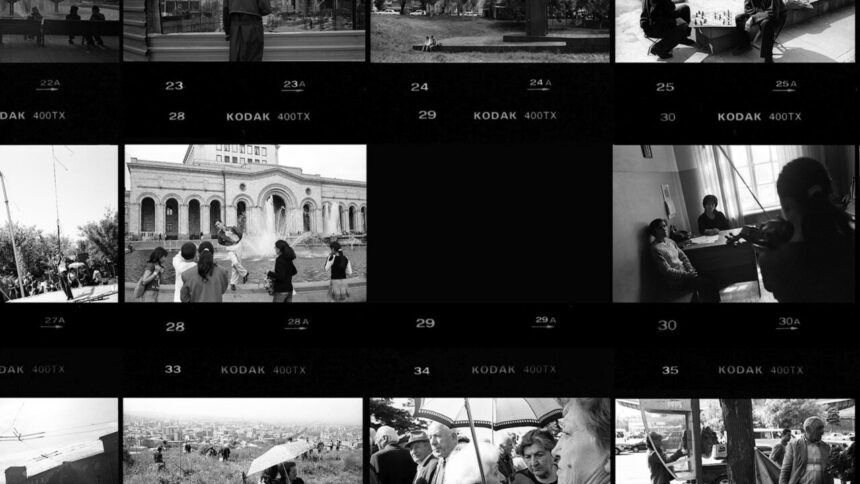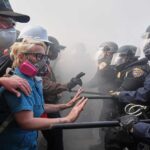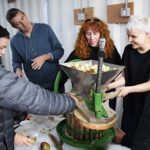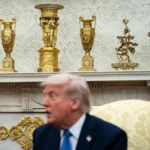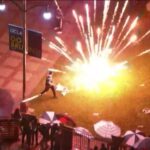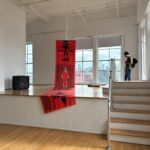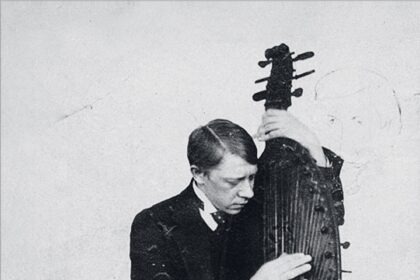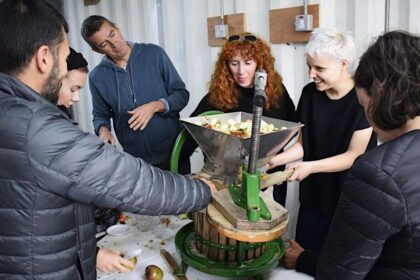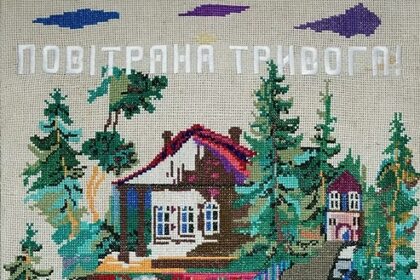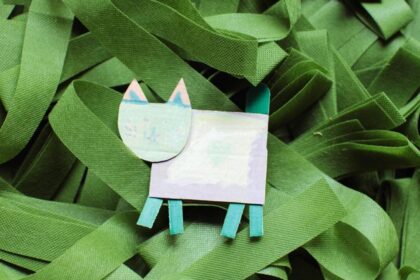Seen/Unseen: A Report on the State of the Arts
Lara Fresko Madra
We enter the fray in an oblique angle, looking down onto what seems like a courtyard. We are looking onto a space outside of windows but contained by four yellow walls making a perfect square. A woman is writing on the wall, though from the severe angle of the camera, we can’t see what. In the middle of the screen, an editing box appears and a voice: “I think we can solve it this way,” at which point I notice two more details about this shot. The central image doesn’t cover the entire screen, it is projected onto a wall, and on the bottom left corner of that image is a coiled strand of razor wire. I can now discern that this is security camera footage from a prison courtyard. We are in post-production with the editors, trying to stitch together footage from a prison CCTV camera and other materials to tell the story of power dynamics, censorship, and fighting for one’s rights, even—or perhaps precisely—while incarcerated.
So begins Seen Unseen: An Anthology of (Auto)Censorship, a documentary which brings together segments from and work processes of six unfinished documentaries. Produced by Altyazı Fasikül (an offshoot of a long-standing cinema journal, focusing on free expression) and bringing together six unfinished documentaries by eight directors (Fırat Yücel, Erhan Örs, Hakan Bozyurt, Can Memiş, Sibil Çekmen, Nadir Sönmez, Serra Akcan, and belit sağ), the 68-minute film is born out of a workshop. In lieu of a report on the state of the arts in Turkey, I offer here a review of this endeavor, which demonstrates not only the various impediments that have arisen in the sphere of documentary filmmaking and the arts but also the solidarities, workshops, and formal innovations that have emerged in response to it. I propose this method also as an important exercise in recognizing what prevails—and how—in difficult times, instead of yielding to the cynicism of ruminating only on losses, absences, and the blinding despair it cultivates.
The next segment “Prologue: Doubts,” enacts the concept by typing, deleting, and retyping the title. Here, footage from the 2013 Gezi Park Protests is overlaid with text messages between editors (with names anonymized as animals: cat, owl, crow, etc.) discussing what the images are, voicing doubt as to what is sayable, grappling with self-censoring impulses, and then shifting to a conversation on what it was about the Gezi Park protests that they want to recapture in their documentary: “Well,” they ask, “what do we want to tell about Gezi Resistance after all these years?” This time, overlaid on moments of joy and chanting, tear gas and arrest footage, the editors continue to text back and forth: “the inexhaustible enthusiasm, the will to claim your city, the extent of police violence, the resilience, the abundance of cameras despite censorship, the pace of the events and images…” The text bubbles offer a simple formal intervention to introduce the multitemporal stakes of the documentary—trying to capture what had transpired then and how it might be communicated in its aftermath.
Between the six different documentaries, the subjects, methods, and aesthetics, change drastically. The first oblique shot returns in the second documentary, concerned with a trial regarding the censorship against incarcerated women who wrote on the internal walls of the prison with shoe polish and olive paste—both easily removable, yet the act of writing is so threatening to the state while simultaneously so necessary for the prisoners. Midway through is a documentary about the numerous documentaries that have not been made, told through conversations with their directors. A director’s retelling of their family’s repressed Armenian heritage, another’s appeal to UNESCO for the preservation of the heritage of cruising as a cultural practice, and an artist’s experience with their work being destroyed during an exhibition close out the six documentaries. Yet, the piece concludes with the same oblique angle from the prison courtyard that it had begun with, suggesting a formal and conceptual enclosure. The six incomplete documentaries make up one, almost as if they were thin books that could only stand on a shelf if they supported each other.
The state of documentary filmmaking, or any kind of filmmaking, or any expression for that matter, in Turkey may have never been easy. However, in the past two decades, the impediments to creative expression have gotten to the point of absurdity, starting most visibly with the blurring of cigarettes, alcohol, and brand names from all television programming, including international channels. Yet the imposition on finished work is only the top layer of the censorship. It is the political chilling effect and the encumbrance of the material conditions that hinder creative expression to begin with. As I write, Çiğdem Mater, a documentary filmmaker, remains incarcerated in Turkey for a documentary she did not make about the Gezi Park protests. Osman Kavala, who, through Anadolu Kültür’s philanthropic efforts, has supported many a documentary, has been incarcerated since 2017 with no possibility for release in sight.
Seen Unseen drives this point home without falling into a cynical despair, enacting the possibility (if imperfect and incomplete) in the face of it all. Hope after all, is a discipline and requires persistent practice.
Lara Fresko Madra is an Assistant Professor and Luma Fellow at the Center for Curatorial Studies at Bard College. She received her PhD in Art History from Cornell University, with her current research focused on spectrality and time. Lara Fresko’s research is concerned with the curatorial and artistic practices that engage with the past in alternate modes that rethink or challenge official historiography as sanctioned by the state (particularly in relation to Turkey and the Middle East.) She has published her writings in Afterall, Artforum, Art in America, Diacritics Blog, JVC Magazine, and multiple exhibition catalogs.

